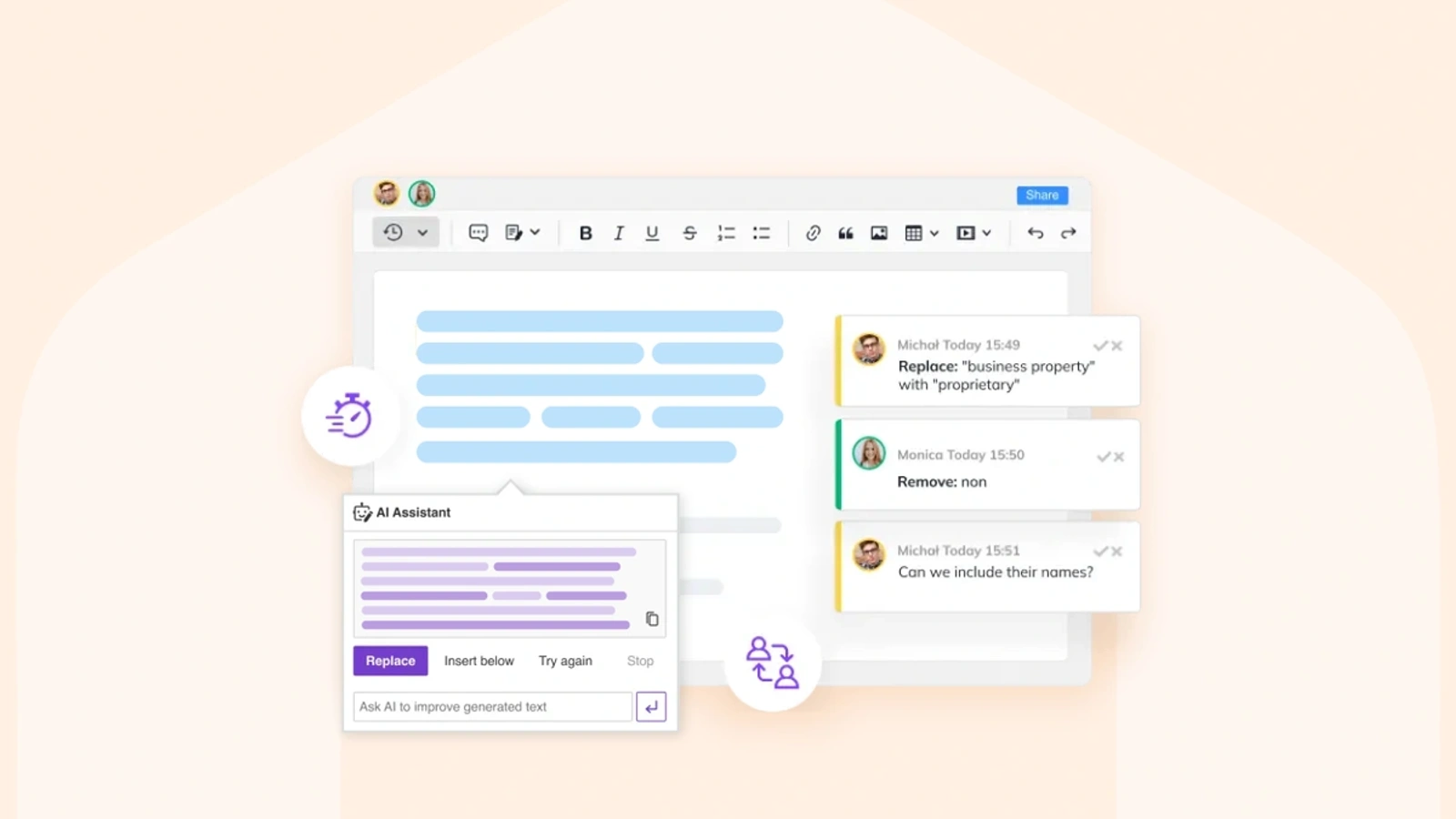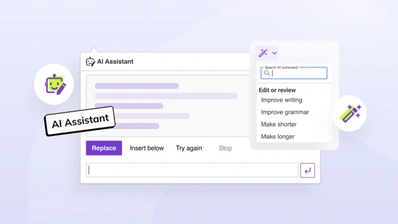AI and collaboration: Revolutionizing business operations and outcomes

From boardrooms to newsrooms, artificial intelligence (AI) is an inescapable topic of conversation right now. Freely available generative AI apps like ChatGPT, Google Bard, and Stable Diffusion have captured people’s imagination – and businesses are taking notice. Forrester expects 97% of organizations will implement generative AI in their workplace within the next two years. In order to reap the benefits of the new technology, companies need to understand how to harness AI collaboration.
Unlike an instant messaging platform or a CMS, AI is more than just another business tool. Adopting AI on its own won’t get you very far – the benefits of AI come from humans working together with artificial intelligence to be more productive and creative. Using an AI assistant for business is an entirely new way of thinking and working.
So far, discussions of AI in the media have portrayed it as a kind of genie in a bottle, able to instantly grant users whatever they ask for. But the reality is quite different.
As anyone who’s used one of the many AI assistants out there knows, it can write a report much faster than you can, but it won’t be perfect on the first try. To get the outcome you want, you need to take time to review the report and give feedback on drafts – just like working with any other colleague.
On the future of AI assistants for business, Wayne Kurtzman from market research firm IDC says:
Generative AI, over time, may be that virtual colleague you didn’t know you needed… Every collaborative application will increase their use of AI over time.
Given that AI is more effective as a partner, rather than a replacement for people, it’s important to understand how AI can help you before rushing to deploy it. If collaborative AI is like working with a colleague, then what exactly does using AI bring to the table?
How does AI collaboration help businesses?
Broadly speaking, AI is much better than humans at two types of tasks: automation and iteration.
AI, like most software, is naturally adept at performing routine repetitive tasks quickly and consistently. This has been true since the early days of AI. Think of spell checking, formatting documents, data entry, and more. People can easily do this work, too, but it’s laborious and time-consuming for them, making it an ideal task to be automated.
Iteration is one area where modern AI assistants really excel.
For example, a generative image-based AI, like Dall-E or Midjourney, can create hundreds of different images all based on the same prompt. None of these images may be ideal on the first try, but they can act as starting points to spark a designer’s creativity. And, if a particular image stands out to the designer, they can ask the AI to iterate on it – tweaking and refining the image until it suits their needs.
In contrast, asking a human to produce so many drafts so quickly is totally impractical.
Collaborating with AI to automate routine tasks and iterate on more creative work brings a range of benefits for businesses.
5 benefits of an AI assistant for business
1. Boosted productivity
Scientific studies of AI in the workplace show that people collaborating with an AI assistant write up to 40% faster than those working without one. AI collaboration also improves the quality of their work – using AI to iterate on an idea enhances people’s own creativity.
2. Higher job satisfaction
Rather than making people worry about being replaced, introducing an AI assistant for business actually helps people enjoy their work more. One of the most frustrating things about writing or creating something is starting with a blank page, but with AI’s ability to iterate, the page doesn’t stay blank for long.
3. Improved efficiency
Using AI to automate repetitive tasks, businesses can streamline processes and reduce the chance of human error. Forrester found that companies regularly using generative AI saved an average of 13 hours every week, freeing up time for people to work on more important things.
4. Cost savings
By automating tasks that typically require people to spend time managing, businesses can significantly reduce costs. IBM found 54% of companies that have deployed AI for automation reported cost savings as a result of more efficient processes.
5. Enhanced collaboration
An AI assistant for business can facilitate seamless collaboration by providing automated real-time updates, scheduling meetings, and acting as virtual project manager. Or, AI can be a super-competent personal assistant, taking meeting notes, summarizing documents, and helping with communication.
That last point is worth highlighting. Not only can AI be the virtual colleague you didn’t know you needed, it can also help improve collaboration between you and your colleagues.
How to collaborate better using an AI assistant
Beyond creating content, an AI assistant for business can also help make communication between you and your colleagues much smoother. AI isn’t limited to iterating on new content – it can also transform existing content, too. Often, the most effective AI collaboration involves using an AI assistant that can:
-
Summarize long text
-
Translate between different languages
-
Simplify complex text
-
Change tone and style
For example, imagine you’ve missed a team meeting where important decisions were made, but the meeting has been recorded and transcribed. Rather than spend an hour or two watching the video and reading the transcript, a collaborative AI assistant can summarize the transcript for you.
Or perhaps your colleague in Shanghai finds it difficult to follow your English-language messages. With a little AI collaboration, you can email your teammate in Chinese instead. Similarly, if you’re short on time, you could write a casual first draft of an email to a colleague and then get AI to give it a more business-oriented tone.
In all these ways and more, a collaborative AI assistant for business can help teams work together more smoothly. But in order to reap the benefits, businesses need to implement AI using a holistic, collaboration-first approach.
Collaborative AI must be embedded companywide
Companies that rushed to adopt AI quickly have typically treated it as another productivity app, like their project management platform, or CMS. So far, AI in the workplace has often been limited to specialized use cases and more technical areas.
But Forrester reports that 90% of people working at businesses that use AI want access to a companywide AI collaboration solution. The report, titled Maximizing Business Potential With Generative AI, summarizes the problem perfectly:
If a solution can’t support cross functional collaboration and doesn’t work where employees work, it’s an incomplete solution. This means that for many use cases, GenAI will be more beneficial as an embedded functionality than as a standalone app.
The best way to get all the benefits of AI collaboration is by ensuring AI is deeply integrated into your most fundamental platforms.
Simply bolting AI features onto your CMS or intranet isn’t enough. You need collaborative AI to be available at the front lines of content and communication. And the cornerstone of content creation in software is your rich text editor.
Integrate AI collaboration into your business with CKEditor
Using CKEditor’s AI Assistant (Premium) plugin, you can integrate collaborative AI into all your business platforms. Anywhere colleagues do their work – your CMS, your document management system, your customer relationship software, and more – can have AI built into it.
Instead of having to swap to another app to get AI assistance, people can collaborate with the AI from inside the editor.
CKEditor’s AI Assistant is powered by leading AI models and is ideal for both automation and iteration. You can use the built-in prompt input to get the AI to automatically highlight a specific word, or make a table. Plus, you can iterate on existing text with quick commands, including summarize, translate, simplify, and change tone or style.
Currently using a different WYSIWYG editor?
CKEditor is a customizable, collaboration-first rich text editor that’s perfect for modern tech stacks. Its modular architecture gives you total control over the feature set and integration, so swapping to CKEditor doesn’t mean you’ll be sacrificing anything.
A CKEditor Commercial Licence lets you integrate the editor into your platform. You can also pick and choose from a range of Premium plugins, including AI Assistant and leading-edge real-time and asynchronous collaboration features.
To get all the benefits of AI collaboration with your team, contact us today.


